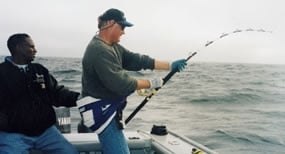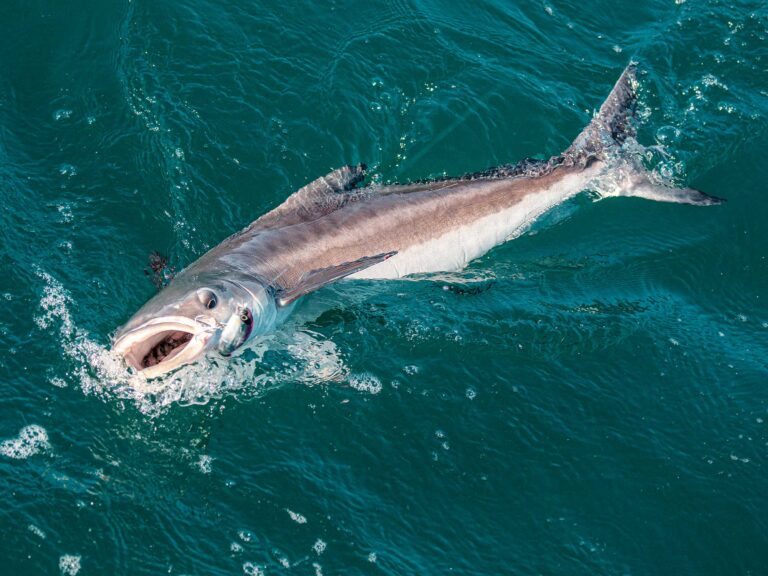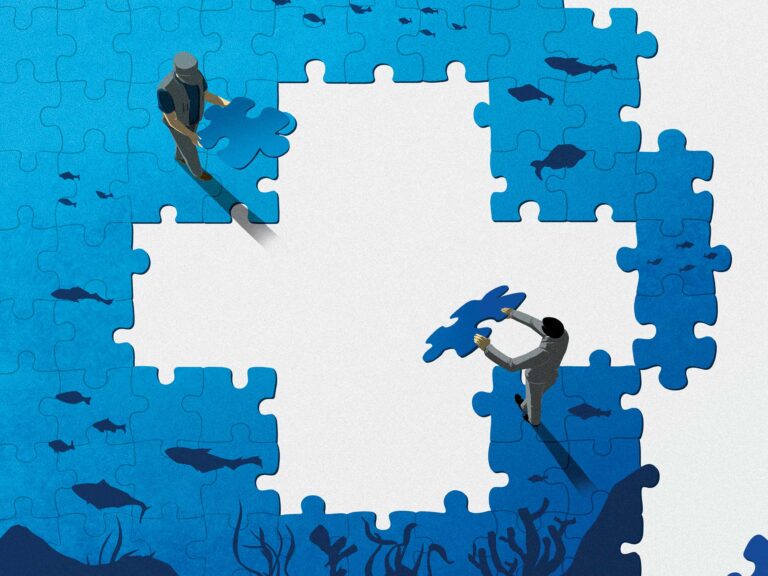
| Hunter Von Leer’s last mako of the 2002 season weighed in at 591 pounds and took 4 1/2 hours to beat. Later, the crew found a porpoise inside the shark’s stomach. |
eteran sharker Hunter Von Leer had been drifting all day, but the only things interested in his chum were a few seabirds and a three-foot “pup” mako that was sniffing around the slick. Suddenly, the birds took flight and the small shark disappeared. It didn’t take long for Von Leer and his three-man crew to figure out why: the largest mako any of them had ever seen was working its way up the chum slick, heading straight for the slab of mackerel on the end of their line.
Hours later, back at the dock, the fate of the smaller mako became evident when it spilled out of the maw of the monster shark. The big mako – the first of four fish over 500 pounds Von Leer has caught in the last couple years – weighed in at 582 pounds and set a new California state record at the time.
Mike McNamee is another top shark fisherman who knows all about big makos. In fact, he won the Mako for Dollars Tournament this past summer with a 720-pound, record-breaking fish that inhaled a giant squid bait. About two weeks later he received a phone call from a Vessel Assist dispatcher telling him that his buddy, John Miller – who was fishing alone – was hooked up to an even bigger shark and needed help. By the time McNamee arrived on the scene some ten miles off Catalina Island, Miller had been fighting the fish for 4 1/2 hours. McNamee jumped aboard with Miller and – after the shark bent their first flying gaff “like a pipe cleaner” – the two men eventually managed to subdue the giant mako, which later weighed in at 815 pounds.
Mako Central
In recent years, Southern California – particularly the waters between the Channel Islands and Dana Point – has become one of the country’s premiere places to catch makos weighing from 400 to 800 pounds. And reliable eyewitness accounts from local shark experts indicate that there are much bigger specimens out there, waiting for the angler with the right combination of luck, skill and stamina.
The SoCal mako season runs from May through the fall; however, finding the fish isn’t so easy, because the biggest sharks travel alone. Most experts agree that one clue to the big makos’ whereabouts is the presence of clear, blue water of the right temperature. “Makos are semi-tropical fish, and tend to move in en masse when the surface temperature reaches 64 to 68 degrees,” says Von Leer. “When the water gets much warmer than this, you get a lot of rats (small makos) moving in. Once the warm water is scattered up and down the coast, I’ll look for pockets of cooler (62 to 63 degrees) water, which tend to harbor the bigger fish. It’s thought that big makos can regulate their body temperature, allowing them to travel and feed in these cooler zones. If I find a temperature break and good, clean water, I’ll always focus on the cool side of the break.
“I also look for ‘fishy’ areas – places with a lot of visible life such as baitfish, birds, porpoises and the like. With experience, you learn to study the water and you just know if it’s a good area or not.”
Where to Look

Redondo Canyon has been a hot spot for giant makos in recent years. This electronic chart depicts an effective drift through the heart of the canyon.|
Even though makos can show up wherever and whenever conditions suit them, there are some key areas to focus on. One is the expanse of water between Santa Barbara Island and Catalina Island, particularly around the offshore bank known as the 172. This is part of a larger area known as the Tuna Ridge, which encompasses the 172, 175 and 17 Fathom spots, and it produces its share of big makos each season.
“You can never go wrong if you fish the tanker lanes,” adds Von Leer, referring to the shipping channels about 15 miles off Santa Monica Bay. These areas, which are clearly marked on most charts, roughly parallel the edge of the continental shelf and provide a natural highway for prowling makos.
Plotting for Makos
Veteran angler and shark aficionado Steve Quinlan brings his own unique perspective to the mako game. A long-time fresh water bass angler, Quinlan has successfully adapted structure-fishing techniques to his quest for makos.
One of his favorite areas to fish is Redondo Canyon, a vast underwater chasm off Santa Monica Bay that runs perpendicular to the coast. He relies heavily on his chart plotter and detailed electronic charts, both to locate the right area and to position his vessel for the best possible drift.
“I always start off with a five-minute test drift while we’re setting up our gear,” says Quinlan. “By determining my drift speed and heading on the plotter, I can see how I’m going to move in relation to the structure. This lets me choose my starting position so I can establish a good slick and drift right down the heart of the canyon. By monitoring my progress on the electronic charts during the drift, I’m also able to move my boat to keep my drift where I want it.” Quinlan uses this same technique to pinpoint underwater structure, whether he’s fishing Redondo Canyon, the shipping lanes or an offshore bank.
The Art of Chum
Fishermen who specialize in catching big makos almost always fish by sight. They won’t even put a line in the water until the fish they want is right at the boat, hopefully teased into a frenzy by the smell of the chum it followed for miles.
“The whole idea of chumming is to put out a mako ‘spiderweb,’ and the bigger it is, the better,” says Quinlan. “The night before a trip I’ll study my electronic charts and look at the satellite sea-surface temperatures to plan out the day. I’m looking for an area where I can drift all day in good conditions and create a chum slick that might be six to ten miles long.”
| ### Winning the End Game | ||
| Battling big makos is a dangerous game, particularly when it’s time to subdue a quarter-ton or more of big teeth and bad attitude. A well-trained crew stands a much better chance of coming away with the prize – not to mention all of their arms and legs intact. Here are some end-game tips from the experts: 1. Keep it Calm ¿ Keep the boat motoring ahead at the same speed as the fish to help keep it calm. If you stop moving or back down on the shark, it will often send the fish into a boatside tantrum. ¿ 2. Leave the Guns at Home ¿ In addition to the inherent danger of brandishing a weapon on a crowded, tossing boat, fish shot with a firearm won’t count in most tournaments and definitely won’t qualify for state- or world-record consideration. ¿ 3. Keep Your Distance ¿ Don’t pull the fish too close to the boat; instead, keep it five feet off the side until the gaff is ready and your crew is in position. Make sure the leader man is forward of the gaff man. ¿ 4. Get the Point ¿ Use a fixed gaff for fish weighing less than 200 pounds, a flying gaff for larger sharks. Hit the fish across the back in front of the dorsal fin, pin it to the side of the boat and secure it with a tail rope and head rope. ¿ 5. Finish the Job ¿ Don’t lift the mako’s tail or head out of the water. You can use a heavy butcher knife to dispatch the fish before securing it to your swim step. Never bring any shark in the boat unless you’re certain it’s dead. – Ron Ballanti |
Serious mako hunters have raised chumming to an art form, complete with tricks and secret formulas designed to capture the sharks’ attention. “I always like to power-chum a few minutes before starting my drift,” said Von Leer, referring to the popular technique of idling ahead while dragging a chum bucket or fish carcass behind the boat. This is a good way to “jump-start” the slick with a trail of scent, after which the wind and current can take over.
Frozen shark chum is available at many tackle stores and marinas. These concoctions of ground fish, oil, blood and guts certainly have convenience going for them. Frozen in ready-to-use buckets, they are easy to store and deploy, and account for their share of big makos. Other anglers scoff at the idea of store-bought chum, preferring to use everything from whole tuna and salmon carcasses to bags of fish blood to ten-gallon jugs of menhaden oil imported from the East Coast.
Whatever taste treat you decide to use, one thing is clear: patience is key. “You need to stick with it all day,” says Von Leer. “Even if a mako is five miles away when he intercepts your slick, he’ll get to you eventually. They’re the fastest sharks in the ocean. That’s why I won’t ever break my chum slick unless another boat sets up within a mile of me or the water conditions change for the worse.”
Techniques & Tackle
Tempting a giant shark to your swim step is a big part of the game, but you also need to bait, fight and – if you’re lucky – land your quarry. Quinlan advises keeping an eye on the birds that usually gather along the length of the slick. If they leave the scene, it’s a good sign that a mako is moving up the line.
Von Leer adds that bait behavior can also be a clue. “If there are a lot of mackerel and other baitfish in your chum slick and they suddenly split, it’s time to start paying attention,” he says.
Shark experts advise having several bait rods rigged and ready, so you can choose the outfit based on the size of the fish. “When you see a giant fish come right to the boat, your knees will start knocking, no matter how many times you’ve done it,” warns Quinlan. If you have your rods ready in the gunwale holders (usually baited with mackerel slabs, squid or fish chunks), you can simply drop the bait right in front of the fish.
For the biggest sharks, you need heavy weaponry. Von Leer uses International 50W reels spooled with Spectra backing and 80-pound mono, as well as two-speed International 70s spooled with straight 80-pound mono. He rigs the smaller outfits with ten feet of heavy single-strand wire and ten feet of 300-pound mono leader attached to the main line with a big barrel swivel. He keeps several of these setups ready to go, armed with hooks ranging from 8/0 to 12/0. His heavy rods – which don’t see action unless a true giant shows up – are rigged with 30 feet of 600-pound, multi-strand wire and nothing smaller than a 12/0 hook.
“You should watch the fish eat the bait, so you know when it’s ready. Then, with the reel in free-spool, have a crewmember motor away from the fish before you set the hook,” Quinlan says. The idea is to get the fish away from the boat so it won’t “freak out,” bolt under the boat and cut you off.
It Takes a Team

When fighting a monster mako on stand-up gear, it’s a good idea to wear a safety line – or at least get a crewman to lend a hand.|
“The angler doesn’t catch the fish, the team does,” says Von Leer, echoing the sentiments of all experienced mako hunters. From start to finish, a mako battle gets everybody onboard involved, from clearing the deck to driving the boat to handling the fish at boatside.
“Everybody has his own job, and you should designate what that is before you start fishing,” says McNamee. “Good teamwork is especially important at the end of the fight. That’s the time when most big fish are lost, right at the boat where they can break your heart.”
There is every indication that the influx of big makos into Southern California waters will continue this season. On a recent trip, Quinlan hooked a large shark that immediately broke him off. Not long afterwards, a mako estimated at 12 feet long and 1,000 pounds, based on the 8 1/2-foot beam of the skiff, ate Quinlan’s chum bucket and swam away with it, rope and all. The experience left him with a clear understanding of just how large Southern California makos can get . . . and a score to settle this season.
Frequent contributor Ron Ballanti has traveled and fished all around North America, including Baja, Alaska, the Gulf Coast, Florida and New England. He lives in Southern California with his wife and two children. – Ed.









